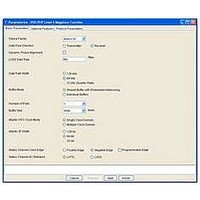IP-POSPHY4 Altera, IP-POSPHY4 Datasheet - Page 114

IP-POSPHY4
Manufacturer Part Number
IP-POSPHY4
Description
IP CORE - POS-PHY Level 4 SPI 4.2 Interface
Manufacturer
Altera
Type
MegaCorer
Datasheet
1.IP-POSPHY4.pdf
(144 pages)
Specifications of IP-POSPHY4
Software Application
IP CORE, Interface And Protocols, COMMUNICATION
Supported Families
Arria GX, Cyclone, HardCopy, Stratix
Core Architecture
FPGA
Core Sub-architecture
Arria, Cyclone, Stratix
Rohs Compliant
NA
Function
POS-PHY Level 4 Interface, Link-Layer/PHY Layer
License
Initial License
Lead Free Status / RoHS Status
na
Lead Free Status / RoHS Status
na
- Current page: 114 of 144
- Download datasheet (3Mb)
A–4
POS-PHY Level 4 MegaCore Function User Guide
4. Data channel does not sync. This problem can be detected when
5. Data channel syncs but only training patterns are received. This problem can be
6. Receive MegaCore function detects DIP-4 errors during normal transmission. The
stat_rd_rdat_sync remains low or toggles. The following tips may prove useful:
■
■
■
detected when stat_rd_rdat_sync goes high, but no data is received, and
stat_rd_tp_flag toggles. The following tips may prove useful:
■
■
■
■
■
■
■
■
following tips may prove useful:
■
■
altlvds_rx_component.pll_bandwidth_type = "low"
Ensure all resets are released.
Ensure all clocks are up, and measure clock frequencies.
Ensure training patterns are received.
For 128-bit receiver variations, ensure that the rxsys_clk to rdint_clk ratio is
set according to the receive clock setting in
Ensure that the calendar length and calendar multiplier are set to the same
values in both devices.
Verify timing requirements for the status channel
Select the clock edge that drives or samples the clock with ctl_ts_statedge
and ctl_rs_statedge.
Verify t
ALTDDIO megafunction keeps on-chip skew to a minimum.
Verify board skew for rsclk/rstat
Verify the setup and hold times for tstat on tsclk in the transmit MegaCore
function. The ALTDDIO megafunction keeps on-chip skew to a minimum.
Verify that tsclk is operating at the correct frequency.
The receiver MegaCore function (non-DPA variations) assume that the data is
edge aligned. The alignment can be changed at the receiver and transmitter. It
is easier to change the receiver by specifying a different alignment using the
INCLOCK_DATA_ALIGNMENT parameter of the ALTLVDS megafunction. In the
transmitter, the tdclk can be driven by a PLL clock output instead of a SERDES
data output, and the phase relation can be selected. There are notes on how to
do this in the top-level file. In either case the functional simulation models
need to be refreshed using the tool command language (Tcl) script provided.
Refer to the
for details.
This issue could be jitter related. Try adjusting the bandwidth of the PLLs. In
the fast PLLs, embedded in the ALTLVDS megafunction, this is done by adding
a pll_bandwidth_type parameter to the ALTLVDS instance. This parameter
can be low, medium, high, and defaults to auto, which should be high. The
following code is a Verilog HDL code example:
co
for the rsclk and rstat pins in the receiver MegaCore function. The
SERDES Transmitter/Receiver (ALTLVDS) Megafunction User Guide
Table C–1 on page
December 2010 Altera Corporation
Appendix A: Start-Up Sequence
C–1.
Troubleshooting
Related parts for IP-POSPHY4
Image
Part Number
Description
Manufacturer
Datasheet
Request
R

Part Number:
Description:
IP CORE Renewal Of IP-POSPHY4
Manufacturer:
Altera
Datasheet:

Part Number:
Description:
IP Thermal Transfer Printer With Peel/Present Option
Manufacturer:
BRADY

Part Number:
Description:
CYCLONE II STARTER KIT EP2C20N
Manufacturer:
Altera
Datasheet:

Part Number:
Description:
CPLD, EP610 Family, ECMOS Process, 300 Gates, 16 Macro Cells, 16 Reg., 16 User I/Os, 5V Supply, 35 Speed Grade, 24DIP
Manufacturer:
Altera Corporation
Datasheet:

Part Number:
Description:
CPLD, EP610 Family, ECMOS Process, 300 Gates, 16 Macro Cells, 16 Reg., 16 User I/Os, 5V Supply, 15 Speed Grade, 24DIP
Manufacturer:
Altera Corporation
Datasheet:

Part Number:
Description:
Manufacturer:
Altera Corporation
Datasheet:

Part Number:
Description:
CPLD, EP610 Family, ECMOS Process, 300 Gates, 16 Macro Cells, 16 Reg., 16 User I/Os, 5V Supply, 30 Speed Grade, 24DIP
Manufacturer:
Altera Corporation
Datasheet:

Part Number:
Description:
High-performance, low-power erasable programmable logic devices with 8 macrocells, 10ns
Manufacturer:
Altera Corporation
Datasheet:

Part Number:
Description:
High-performance, low-power erasable programmable logic devices with 8 macrocells, 7ns
Manufacturer:
Altera Corporation
Datasheet:

Part Number:
Description:
Classic EPLD
Manufacturer:
Altera Corporation
Datasheet:

Part Number:
Description:
High-performance, low-power erasable programmable logic devices with 8 macrocells, 10ns
Manufacturer:
Altera Corporation
Datasheet:

Part Number:
Description:
Manufacturer:
Altera Corporation
Datasheet:

Part Number:
Description:
Manufacturer:
Altera Corporation
Datasheet:











